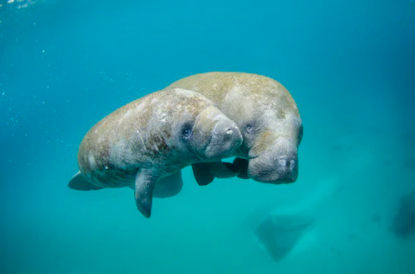Seagrass ecosystem contributions to people’s quality of life in the Pacific Island Countries and Territories

McKenzie et al. 2021
Seagrass meadows are receiving growing attention, especially in relation to their potential for carbon sequestration. However, a broader appreciation of the contributions of seagrass meadows to people’s quality of life will inform better interventions that enhance seagrass ecosystem health whilst also benefiting local people.
This paper reviews how seagrass in the Pacific Islands contributes to the lives of local people, shining a spotlight on just how important these ecosystems are. 30 different Nature’s Contributions to People were reported as present in the Pacific Islands; these can be split into three broad types of contributions:
1) Material contributions, such as:
- Productive fishing grounds.
- Food for dugongs and sea turtles, which are important protein sources and of high cultural significance in some locations.
- Source of ornamental products e.g. shell money used as currency in dowry ceremonies.
- Consumption of seagrass as a dietary supplement.
- Use of seagrass fibre for catching shrimp.
- Use of harvested seagrass as fertilizer for agriculture.
- Medicinal use e.g. to relieve fish stings.
- Indicator of coastal ecosystem health.
2) Non-material contributions, such as:
- Language and cultural e.g. seagrass is known by 14 different names across the Solomon Islands, reflecting its local importance.
- Spiritual significance of seagrass; it is considered sacred by some coastal Indigenous peoples e.g. in Roviana (Solomon Islands) fishers use seagrass fibres in a ceremony to call seagrass spirits to improve their catch.
- Spiritual significance of seagrass inhabitants, especially dugongs and turtles e.g. in Polynesia, the green sea turtle’s migration from seagrass feeding areas to nesting beaches echoes the navigational spirit or islander ancestors.
- Seagrass protects culturally significant artifacts and archaeological sites.
- Recreation and tourism e.g. dugong viewing is an important form of tourism in Vanuatu.
3) Regulatory contributions, such as:
- Sediment stabilisation.
- Carbon sequestration.
- Regulation of natural hazards.
The authors warn that the strong focus on just one of these contributions – carbon sequestration – can lead to policies and projects that side-line the direct benefits that seagrass meadows have for local people and overlook the cultural importance of these ecosystems. Such “blue carbon blindness” can lead to lack of emphasis in policies of customary tenure, and access and use by local people.
Instead, the close cultural connection between people and seagrass ecosystems provides an opportunity for empowering communities as part of restoration action. Central involvement of communities in gathering evidence on seagrass can spread awareness of the threats to seagrass resources, encourage improved environmental stewardship, and through increased engagement and scientific literacy may help build the political influence of local people, enabling them to drive policies which conserve seagrass ecosystems in a way that contributes directly to their quality of life. Valuation of blue carbon in seagrass meadows could still be useful for funding conservation, such as through payments for seagrass stewardship, but such projects must be led by local communities such that they enhance the direct contributions of seagrass to their quality of life.
Read the full paper here.




